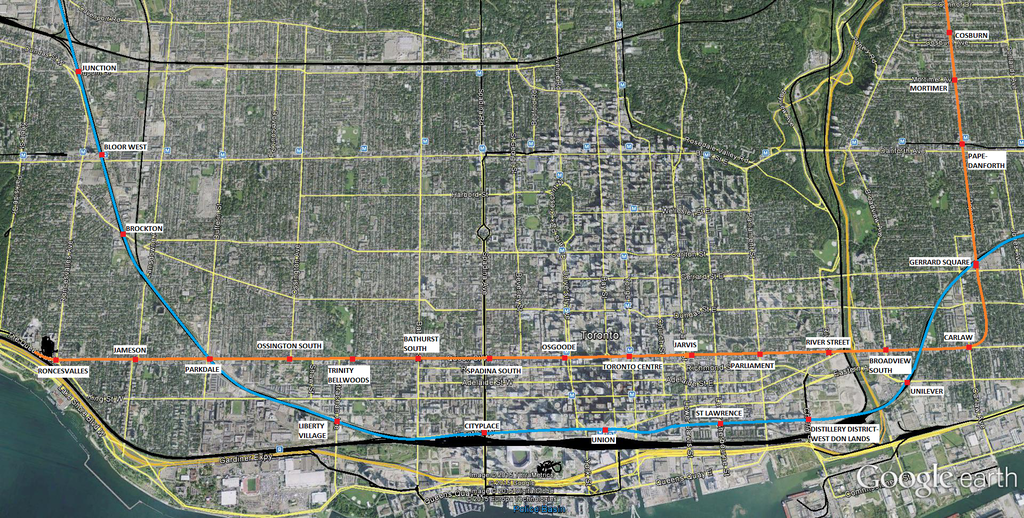Bingo!
I just whipped this map up for scrutiny:

Wow, great map. I would be so happy if this is what actually gets built, with that exact stop spacing (both for the DRL and GO-RER). The core would have such good coverage. What you've shown looks very much like the historical proposals for the Queen line.
I think with Smarttrack in the mix, the Queen/Pape (Corridor B) is the best choice now, as you don't want the services competing (like with Smarttrack/Scarb subway) and it makes two alternatives for downtown located in the city in different areas. Also, that alignment seems to have the highest ridership per stop (all green) It also connects to the Lakeshore GO Line, which would create a mobility hub and take the load off Union (people would get off here and transfer to DRL to get to downtown)
+1
I personally believe that they are leaning towards Corridor D, but Corridor B is also a worthy contender IMO
+1
Corridor A is a clear loser. It provides zero neighbourhood access East of the Don. No connection to GO RER or SmartTrack. Does not support future development in the West Don Lands that we know will happen. No direct connection to Greenwood. And no connection to Unilever. With Tory as Mayor, and him being best buds with First Gulf, can you imagine them not lobbying him for a DRL connection? Please. I can't see this one going forward.
Yeah, but it's the cheapest, so it has that going for it. Also, I feel like these reports are supposed to have options that can easily be eliminated to make the remaining options look better.
From what has been presented, I think option B with a downtown alignment along Richmond or Adelaide is the way to go. Hopefully they would be able to tunnel between the supports for both the Queen bridge and the FPL. Station box construction for the CBD station would be less disruptive on one of those streets than Queen or King. It also maintains a distance between the Relief Line and the RER.
I thought that, based on their preferred station locations, Adelaide had been disfavoured compared to Queen and King. I think that the construction is going to significantly disrupt the streetcar lines regardless of which corridor is chosen, and that it's better to endure the short-term pain of construction for the long-term gain of convenient connections than to pick a route that only approximates where people want to go. Plus, I'm pretty sure an adelaide alignment would mean both the Queen and King streetcars would be eliminated.
In my transit-world fantasy, while station construction is going on at Queen, streetcars are routed through King, which has been turned into a transit mall to handle the additional streetcar traffic (or vice-versa, if King is chosen for the DRL). After the line has been constructed, service is permanently ended on Queen (or King) and the transit mall stays, with the additional streetcars redeployed from Queen (or King).
On the same vein, I wonder if they're considering SmartTrack effects on the Relief Line, it seems like it would make most sense to put the DRL as north as possible.
+1
As for other posts thinking we'll have an intercept station at Queen and the Don River for a GO Richmond Hill line...yeah, that's not happening. There's no space for an RH platform. And even if there was, we wouldn't be allowed to build a station next to the volatile Don this far south.
I had the impression that the station would be at River street, not directly next to the Don. The connection to the RH line isn't the best, but flooding shouldn't be an issue.
Nor are we going to have DRL stations every few hundred metres for that matter. This is a very costly project, one of many this city is undertaking. If the RL is even fortunate enough to make it farther into the planning stages, I think we'd be lucky to see only two stations between Yonge and the Danforth.
That sounds like a pretty awful scenario. For a subway line, the costs are with the tunnelling, the benefits are with the stations. I hope that we don't go through the massive multi-billion dollar expense of a DRL just to build a shuttle between the Danforth line and the CBD, because we'd rather save a couple hundred million than serve the shoulder areas of downtown.
